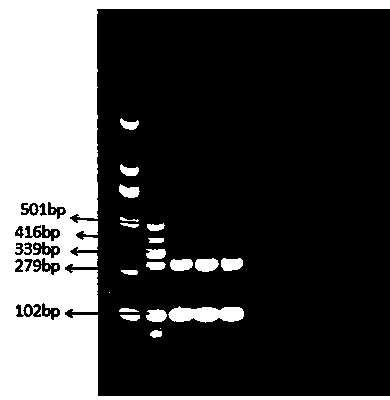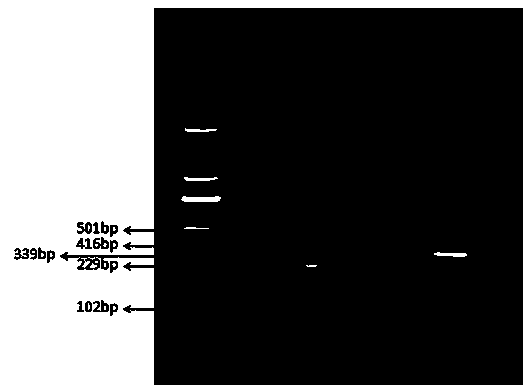Method for detecting staphylococcus aureus and enterotoxin genotypes thereof through multiple PCR (polymerase chain reaction)
A staphylococcus, aureus technology, applied in the detection of Staphylococcus aureus and its enterotoxin genotype in food, food-borne pathogenic microorganisms, can solve the problem of no internal control, etc., achieve good accuracy, strong specificity, The effect of high sensitivity
- Summary
- Abstract
- Description
- Claims
- Application Information
AI Technical Summary
Problems solved by technology
Method used
Image
Examples
Embodiment 1
[0043] Sample: Raw milk sample from a dairy farm
[0044]The milk samples collected from dairy farms were tested and labeled as a, b, c, d, e, f, g, h respectively. Among them, a, b, and c are mastitis milk samples, d, e, f, and g are milk samples from randomly selected cows, and h is a comprehensive sample after milk is poured into the cooling tank.
[0045] 1. Sample processing
[0046] (1) Take 1mL raw milk, add 200uL absolute ethanol, 200uL petroleum ether (or diethyl ether) and 200uL acetone to it, mix well, and centrifuge the mixture at 12000rpm for 10min.
[0047] (2) Discard the supernatant, dissolve the remaining precipitate with 300uL TE (pH8.0), add 10uL (50mg / mL) lysozyme solution, and incubate at 37°C for 1h.
[0048] 2. DNA extraction
[0049] Use the Bacteria Genomic DNA Extraction Kit to extract the total DNA of the bacteria in the raw milk (some steps have been improved), and dissolve the extracted DNA in 84uL 1×TE buffer solution to obtain the DNA template...
Embodiment 2
[0079] Sample: a commercially available milk powder
[0080] A certain commercially available milk powder purchased was tested. Before the artificial contamination of Staphylococcus aureus, the product was sterilized and tested according to the national standard method to confirm that it does not contain Staphylococcus aureus. Artificially pollute the milk powder with the standard strains of Staphylococcus aureus producing A, B, C, and D, that is, take 25g of the sample and add it to 225mL of buffered peptone water for homogeneous mixing, and then artificially pollute the homogeneous solution. Incubate with shaking at 37°C for 12 hours.
[0081] 1. Sample processing
[0082] (1) Take 2mL of emulsion, add 200uL absolute ethanol, 200uL petroleum ether (or diethyl ether) and 200uL acetone to it, mix well, and centrifuge the mixture at 12000rpm for 10min.
[0083] (2) Discard the supernatant, dissolve the remaining precipitate with 300uL TE (pH8.0), add 10uL (50mg / mL) lysozyme s...
Embodiment 3
[0115] Sample: a certain commercially available pork
[0116] A certain commercially available pork was tested. Before the artificial contamination of Staphylococcus aureus, the product was sterilized, and tested according to the national standard method to confirm that it does not contain Staphylococcus aureus. The standard strains of Staphylococcus aureus producing A, B, C, and D were artificially contaminated into pork, that is, 25g of the sample was added to 225mL of buffered peptone water for homogeneous mixing, and then the homogeneous solution was artificially contaminated and cultured with shaking at 37°C for 12h.
[0117] 1. Sample processing
[0118] Take 10 mL of the homogenate and centrifuge at 800 rpm for 5 min to remove the pork and leave the bacterial liquid in the slurry. Draw the supernatant into another sterilized centrifuge tube and centrifuge at 10000rpm for 10min, then discard the supernatant.
[0119] 2. DNA extraction
[0120] Use the Bacteria Genomic...
PUM
 Login to View More
Login to View More Abstract
Description
Claims
Application Information
 Login to View More
Login to View More - R&D
- Intellectual Property
- Life Sciences
- Materials
- Tech Scout
- Unparalleled Data Quality
- Higher Quality Content
- 60% Fewer Hallucinations
Browse by: Latest US Patents, China's latest patents, Technical Efficacy Thesaurus, Application Domain, Technology Topic, Popular Technical Reports.
© 2025 PatSnap. All rights reserved.Legal|Privacy policy|Modern Slavery Act Transparency Statement|Sitemap|About US| Contact US: help@patsnap.com



